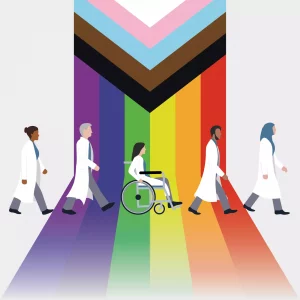by MDSP Blog Admin | Nov 17, 2022 | Around MDSP
Key Takeaways
- On average, women earn only 83 cents for every dollar a man earns.
 The more women in a medical subspecialty, the less money both women and men earn over time.
The more women in a medical subspecialty, the less money both women and men earn over time.- Equalizing salaries immediately after residency completion influences the wage gap more than annual salary growth rates.
By Sarah Handzel, BSN, RN
To access the full article: How much do women in medicine earn compared with men? | MDLinx
by MDSP Blog Admin | Oct 25, 2022 | Around MDSP
“In a recent Wall Street Journal article, the authors equate teaching future doctors about “diversity, equity, and inclusion competencies” to “political re-education” and “wokeness.” They claim that “hyper-class and -racial consciousness that the AAMC wants to instill in doctors may result in worse care for minorities.” Additionally, they predict that it will be difficult to attract new students to medicine if they must “attend to their guilt as racial and political oppressors before they can diagnose your cancer.”
The predominant culture in medicine is still one lacking inclusion and equity. Just look to the last quote above and you’ll see that the authors are addressing a White culture. They fail to address Black, Latino, and other minority races in their comments. As it stands, many highly qualified individuals are left out of medicine due to inequality. It may not be intentional, but it exists. According to the AAMC, 5.8% of practicing US physicians reported to be Hispanic and 5.0% Black. These statistics do not represent our society.
Medicine is still largely a White, male culture. While many may cite other reasons that minorities represent a smaller portion of physicians, especially those in leadership positions, it stands to reason that bias plays a major role. Minorites are often passed up for competitive positions. Patients with complex diseases need a whole team to take care of them, and any bias, apparent or not, needs to be addressed and removed, along with exclusion, racism, and sexism. As the predicted physician shortage rolls out, we need the best hands on deck.
Despite being in the 21st century, people have not overcome racism. In fact, many of our political leaders still seem to struggle with this problem. When our lawmakers can’t mount the racial divide, it spurs further acts of racism. We all saw the unrest that occurred following the George Floyd incident. In medicine, the whole focus should be on treating patients. Any tension, racial or otherwise, that creates a hostile or uncomfortable environment makes it more difficult to treat patients.
With many conditions, minority patients have worse outcomes than White patients. This has been shown in hundreds of studies. Many causes potentially explain this, including distrust of medical professionals. Many female patients choose to see me because I am a woman. Patients tend to trust, and feel more comfortable seeking medical care from, those who look and talk like them. We need diversity to address this. Patients’ lives depend on it.”
Source: https://www.physiciansweekly.com/why-diversity-inclusion-are-needed-in-medicine
by MDSP Blog Admin | Oct 21, 2022 | Around MDSP
“The U.S. could see a shortage of 54,100 to 139,000 physicians by 2033, according to data from the Association of American Medical Colleges cited in a July 25 Time report.
The report laid out six solutions, highlighting that an “innovative multipronged” approach will be required to solve the multifaceted problem.

The solutions:
1. More funding: Some hospital systems have been working to provide more residency spots through additional funding sources amid declining reimbursement from the federal government. These efforts have helped in certain areas, the report said.
2. Debt relief: Student loan forgiveness will be a necessary consideration when it comes to lower-paying specialties like primary care, the report said. A federal funding program to reduce the burden of medical school debt is a key piece of the solution.
3. Technology: Increased use of telemedicine can help ease the burden on physicians while offering care to patients in remote locations.
4. Expanding the care team: Medicine should be moving toward a “multidisciplinary, care team approach,” the report said.
5. Reducing paperwork burden: Delegating less complex medical billing data entry and paperwork to other professionals can free up physician time.
6. Boosting diversity and equity: Working to increase the number of physicians of color should be a key consideration, the report said. Efforts to diversify all areas of medicine should “start well before a prospective doctor is old enough to enroll in medical school.”
By: Patsy Newitt
https://www.beckersasc.com/asc-news/solutions-to-the-physician-shortage.html
by MDSP Blog Admin | Sep 14, 2022 | Around MDSP
“Hospital administrators said that using locum tenens physicians helped boost patient access to care and address staffing shortages by filling vacant positions.
Hospitals are increasingly utilizing locum tenens physicians, advanced practice providers (APPs), and telehealth services to address staffing shortages, according to a report from LocumTenens.com. The COVID-19 pandemic exacerbated hospital staffing shortages as many clinicians faced burnout and mental health struggles, pushing them to leave the field. In addition, hospitals have struggled to recruit new providers to meet the growing care demands of an aging population.
The report found that hospitals’ top concern was attracting talent (25.8 percent), followed by avoiding burnout (20.6 percent) and retaining talent (19.4 percent). Respondents also said that controlling costs (15.2 percent), improving the patient experience (9.4 percent), and scheduling providers (9.05 percent) were areas of concern. Around 90 percent of respondents said they use locum tenens physicians. Nearly 60 percent of those who do not outsource physicians reported that they will consider using locum tenens staff in the future. Over half of respondents (52.3 percent) have been using locum tenens providers or outsourcing physicians for more than five years. Nearly a quarter have been outsourcing for three to five years, while 23 percent have recently turned to locum tenens staff within the past two years.
physicians for more than five years. Nearly a quarter have been outsourcing for three to five years, while 23 percent have recently turned to locum tenens staff within the past two years.
In the past, locum tenens coverage has been accompanied by negative perceptions regarding cost and patient experience. However, healthcare leaders said that using locum tenens providers helped increase patient access to care (68.8 percent), their ability to fill previously unfilled positions (60.9 percent), and staffing flexibility (55.6 percent).”
To access the full article: Locum Tenens Physicians Help Hospitals Address Staffing Shortages (revcycleintelligence.com)
By: Victoria Bailey
by MDSP Blog Admin | Aug 19, 2022 | Around MDSP
“In the 2022
“Radiologist Lifestyle, Happiness and Burnout Report” from Medscape, 49 percent of radiologists reported burnout with radiology ranking eighth among 29 specialties. The COVID-19 pandemic has taken a toll on our communities and our practices. We are working longer shifts than ever before and the demands of our careers are often on a head-on collision course with our personal lives.
. . .
What is my call to action? We are all responsible for addressing burnout as individuals and in our practices. As individuals, we can learn more about self-leadership, self-management and empathy and use our learning to address burnout within ourselves and how we interact with others. At our practices, we can approach burnout systemically, deploying strategies and tactics to take care of our colleagues in more intentional ways. Isolated and alone, burnout is a formidable foe. Together, we can overcome.”
Written By: Chris Mattern, M.D.
To access the full article: https://www.diagnosticimaging.com/view/conquering-burnout-in-radiology-practices

 The more women in a medical subspecialty, the less money both women and men earn over time.
The more women in a medical subspecialty, the less money both women and men earn over time.


 physicians for more than five years. Nearly a quarter have been outsourcing for three to five years, while 23 percent have recently turned to locum tenens staff within the past two years.
physicians for more than five years. Nearly a quarter have been outsourcing for three to five years, while 23 percent have recently turned to locum tenens staff within the past two years.
Recent Comments